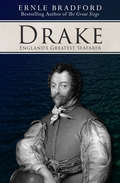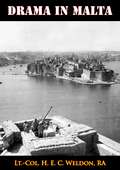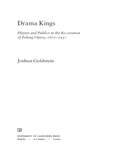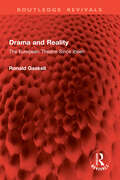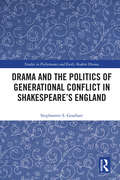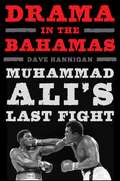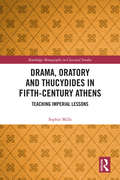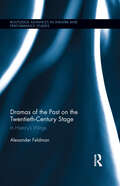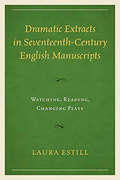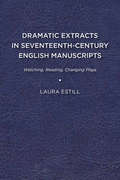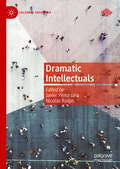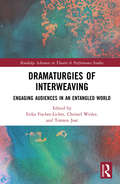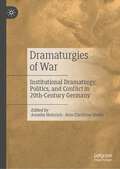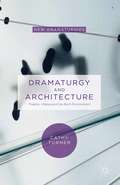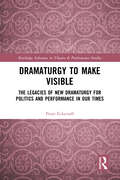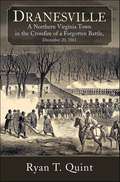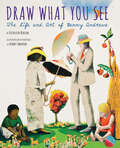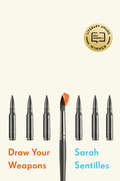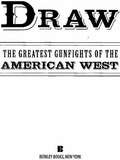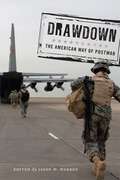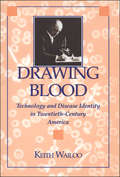- Table View
- List View
Drake: England's Greatest Seafarer
by Ernle BradfordThe authoritative biography of British explorer Sir Francis Drake, from the bestselling author of The Great Siege. Long considered one of the great heroes of British history, Sir Francis Drake was a brilliant navigator, intrepid explorer, and fearsome warrior in Queen Elizabeth&’s Royal Navy. He was also a pirate and profiteer who made a small fortune trading slaves. In this compelling biography, Ernle Brandford offers an unvarnished and finely detailed portrait of this complex and influential man. Born to impoverished parents in Devon, Drake rose to power by his own efforts. In his most famous expedition, he sailed around South America through the Strait of Magellan, opening new trade routes for Great Britain. Continuing across the Pacific and around the tip of Africa, he became the first Englishman to sail around the world. Drake also played a key role in the defeat of the Spanish Armada when England was threatened with invasion in 1588. Vastly outnumbered, he led raids into Spanish ports, destroying dozens of ships. But while tales of his exploits have been told for generations, few authors have approached the story of his life with as much depth, authority, and honesty as Bradford.
Drama In Malta
by Lt.-Col. H. E. C. Weldon R.A.A fascinating personal flashback, Weldon's account of his service as an artillery officer in Malta, 1939-1943, based on notes made during 1939-1943."A great deal of this personal narrative was originally jotted down in Malta during intervals between the raids. The remainder has been added, and the whole of it revised, while "On Active Service". There lie my excuses for any inconsistencies of style the reader may remark and also for the inclusion of certain episodes to the exclusion of others of at least equal importance. So much happened during the four years I lived out there and now, apart from an invaluable page of dry official statistics, I have only my memory to rely on as a guide. So I deemed it better to make the story a personal one and to tell mainly of those matters, whether military, social or dramatic, of which I had intimate knowledge and which would also serve to give a picture of the background to our lives and battles in that isolated little fortress."At the same time I have long felt that there should be wider knowledge of the part that was played by the Army in Malta and in particular by the Royal Regiment of Artillery and its brother in arms, the Royal Malta Artillery. It was by these men, without hope or relief or rest, that the constant strain of three years of bombing, isolation and blockade was borne. The epics of naval heroism that ensured the provisioning of Malta and the doughty deeds of the Royal Air Force in its defence are justly renowned through the press and official publications alike. This pen of mine is a very inadequate instrument with which to describe the contribution of the Army as a whole at its true worth. The back-breaking jobs, the constant vigils and spirited defence of those magnificent battalions of Infantry need a scribe of their own. Suffice it for me to say that the names of Hal Far and the Devons, Luqa and the West Kents, Ta Kali and the Manchesters, Safi and the Hampshires, the Dockyard and the Cheshires, to mention only some, will forever be indissolubly linked in glory and friendship."But over half of the garrison were "gunners"--English and Maltese--and it is because I am immensely proud of having had the privilege both of serving in Malta during those stirring times and of being a humble member of the Royal Regiment of Artillery that these pages are written in honour of:"The Gunners in Malta, 1940--1943."
Drama Kings: Players and Publics in the Re-Creation of Peking Opera, 1870-1937
by Joshua GoldsteinIn this colorful and detailed history, Joshua Goldstein describes the formation of the Peking opera in late Qing and its subsequent rise and re-creation as the epitome of the Chinese national culture in Republican era China.
Drama Kings: Players and Publics in the Re-creation of Peking Opera, 1870-1937
by Joshua GoldsteinIn this colorful and detailed history, Joshua Goldstein describes the formation of the Peking opera in late Qing and its subsequent rise and re-creation as the epitome of the Chinese national culture in Republican era China. Providing a fascinating look into the lives of some of the opera's key actors, he explores their methods for earning a living; their status in an ever-changing society; the methods by which theaters functioned; the nature and content of performances; audience make-up; and the larger relationship between Peking opera and Chinese nationalism. Propelled by a synergy of the commercial and the political patronage from the Qing court in Beijing to modern theaters in Shanghai and Tianjin, Peking opera rose to national prominence. The genre's star actors, particularly male cross-dressing performers led by the exquisite Mei Lanfang and the "Four Great Female Impersonators" became media celebrities, models of modern fashion and world travel. Ironically, as it became increasingly entrenched in modern commercial networks, Peking opera was increasingly framed in post-May fourth discourses as profoundly traditional. Drama Kings demonstrates that the process of reforming and marketing Peking opera as a national genre was integrally involved with process of colonial modernity, shifting gender roles, the rise of capitalist visual culture, and new technologies of public discipline that became increasingly prevalent in urban China in the Republican era.
Drama and Pride in the Gateway City: The 1964 St. Louis Cardinals (Memorable Teams in Baseball History)
by Society for American Baseball Research (SABR)By 1964 the storied St. Louis Cardinals had gone seventeen years without so much as a pennant. Things began to turn around in 1953, when August A. Busch Jr. bought the team and famously asked where all the black players were. Under the leadership of men like Bing Devine and Johnny Keane, the Cardinals began signing talented players regardless of color, and slowly their star started to rise again.Drama and Pride in the Gateway City commemorates the team that Bing Devine built, the 1964 team that prevailed in one of the tightest three-way pennant races of all time and then went on to win the World Series, beating the New York Yankees in the full seven games. All the men come alive in these pages—pitchers Ray Sadecki and Bob Gibson, players Lou Brock, Curt Flood, and Bobby Shantz, manager Johnny Keane, his coaches, the Cardinals&’ broadcasters, and Bill White, who would one day run the entire National League—along with the dramatic events that made the 1964 Cardinals such a memorable club in a memorable year.
Drama and Reality: The European Theatre Since Ibsen (Routledge Revivals)
by Ronald GaskellFirst published in 1972, Drama and Reality is a lucid account of the forces that have shaped modern European theatre, and especially of the different conceptions of reality implied in different plays. Three major views are distinguished (the naturalistic, the subjective, the religious) and related to the choice between poetic and representational form in drama. In the second part of the book, Ronald Gaskell takes a number of plays which offer a distinctive vision—a personal modification of one of the views of the world already discussed—and shows how the form of each play expresses and defines this personal vision.
Drama and the Politics of Generational Conflict in Shakespeare's England (Studies in Performance and Early Modern Drama)
by Stephannie GearhartDrama and the Politics of Generational Conflict in Shakespeare’s England examines the intersection between art and culture and explains how ideas about age circulated in early modern England. Stephannie Gearhart illustrates how a variety of texts – including drama by Shakespeare, Jonson, and Middleton – placed elders’ and youths’ voices in dialogue with one another to construct the period’s ideology of age and shape elder-youth relations.
Drama in Medieval and Early Modern Europe: Playmakers and their Strategies (Themes in Medieval and Early Modern History)
by Nadia Thérèse van PeltDrama in Medieval and Early Modern Europe moves away from the customary conceptual framework that artificially separates ‘medieval’ from ‘early modern’ drama to explore the role of drama and spectacle in England, France, the Low Countries, Spain, Italy, Switzerland, and the German-speaking areas that now constitute Austria and Germany. This book investigates the ranges of dramatic and performative techniques and strategies that playmakers across Europe used to adapt their work to the changing contexts in which they performed, and to the changing or expanding audiences that they faced. It considers the different views expressed through drama and spectacle on shared historical events, how communities coped with similar issues and why they ritually recycled these themes through reinvented or alternative forms that replaced or existed alongside their predecessors. A wide variety of genres of play are discussed throughout, including visitatio sepulchri (visit to the tomb) plays; Easter and Passion plays and morality plays; the French civic mystère; Italian sacre rappresentazioni performed by choirboys in the context of the church; Bürgertheater from the Swiss Confederacy; drama performed for the purpose of royal entertainment and propaganda; May and summer games; and the commercial, professional theatre of Shakespeare and Lope de Vega. Examining the strength of drama in relation to the larger cultural forces to which it adapted, and demonstrating the use of social, political, economic, and artistic networks to educate and support the social structures of communities, Drama in Medieval and Early Modern Europe offers a broader understanding of a shared European past across the traditional chronological divide of 1500. It is ideal for students of social history, and the history of medieval and early modern drama or literature.
Drama in the Bahamas: Muhammad Ali's Last Fight
by Dave HanniganOn December 11, 1981, Muhammad Ali slumped on a chair in the cramped, windowless locker room of a municipal baseball field outside Nassau. A phalanx of sportswriters had pushed and shoved their way into this tiny, breeze-blocked space. In this most unlikely of settings, they had come to record the last moments of the most storied of all boxing careers. They had come to intrude upon the grief."It’s over,” mumbled Ali. "It’s over.”The show that had entertained and wowed from Zaire to Dublin, from Hamburg to Manila, finally ended its twenty-one-year run, the last performance not so much off-Broadway, more amateur theatre in the boondocks.In Drama in the Bahamas, Dave Hannigan tells the occasionally poignant, often troubling, yet always entertaining story behind Ali’s last bout. Through interviews with many of those involved, he discovers exactly how and why, a few weeks short of his fortieth birthday, a seriously diminished Ali stepped through the ropes one more time to get beaten up by Trevor Berbick."Two billion people will be conscious of my fight,” said Ali, trotting out the old braggadocio about an event so lacking in luster that a cow bell was pressed in to service to signal the start and end of each round. How had it come to this? Why was he still boxing? Hannigan answers those questions and many more, offering a unique and telling glimpse into the most fascinating sportsman of the twentieth century in the last, strange days of his fistic life.Skyhorse Publishing, as well as our Sports Publishing imprint, is proud to publish a broad range of books for readers interested in sports-books about baseball, pro football, college football, pro and college basketball, hockey, or soccer, we have a book about your sport or your team.In addition to books on popular team sports, we also publish books for a wide variety of athletes and sports enthusiasts, including books on running, cycling, horseback riding, swimming, tennis, martial arts, golf, camping, hiking, aviation, boating, and so much more. While not every title we publish becomes a New York Times bestseller or a national bestseller, we are committed to publishing books on subjects that are sometimes overlooked by other publishers and to authors whose work might not otherwise find a home.
Drama, Oratory and Thucydides in Fifth-Century Athens: Teaching Imperial Lessons (Routledge Monographs in Classical Studies)
by Sophie MillsThis study centres on the rhetoric of the Athenian empire, Thucydides’ account of the Peloponnesian War and the notable discrepancies between his assessment of Athens and that found in tragedy, funeral orations and public art. Mills explores the contradiction between Athenian actions and their self-representation, arguing that Thucydides’ highly critical, cynical approach to the Athenian empire does not reflect how the average Athenian saw his city’s power. The popular education of the Athenians, as presented to them in funeral speeches, drama and public art told a very different story from that presented by Thucydides’ history, and it was far more palatable to ordinary Athenians since it offered them a highly flattering portrayal of their city and, by extension, each individual who made up that city. Drama, Oratory and Thucydides in Fifth-Century Athens: Teaching Imperial Lessons offers a fascinating insight into Athenian self-representation and will be of interest to anyone working on classical Athens, the Greek polis and classical historiography.
Drama, Politics, and Evolution: Cliodynamics in Play (Cognitive Studies in Literature and Performance)
by Bruce McConachieThis book outlines the evolution of our political nature over two million years and explores many of the rituals, plays, films, and other performances that gave voice and legitimacy to various political regimes in our species’ history. Our genetic and cultural evolution during the Pleistocene Epoch bestowed a wide range of predispositions on our species that continue to shape the politics we support and the performances we enjoy. The book’s case studies range from an initiation ritual in the Mbendjela tribe in the Congo to a 1947 drama by Bertolt Brecht and include a popular puppet play in Tokugawa Japan. A final section examines the gradual disintegration of social cohesion underlying the rise of polarized politics in the USA after 1965, as such films as The Godfather, Independence Day, The Dark Knight Rises, and Joker accelerated the nation’s slide toward authoritarian Trumpism.
Dramas of the Past on the Twentieth-Century Stage: In History’s Wings (Routledge Advances in Theatre & Performance Studies #27)
by Alexander FeldmanThis book defines and exemplifies a major genre of modern dramatic writing, termed historiographic metatheatre, in which self-reflexive engagements with the traditions and forms of dramatic art illuminate historical themes and aid in the representation of historical events and, in doing so, formulates a genre. Historiographic metatheatre has been, and remains, a seminal mode of political engagement and ideological critique in the contemporary dramatic canon. Locating its key texts within the traditions of historical drama, self-reflexivity in European theatre, debates in the politics and aesthetics of postmodernism, and currents in contemporary historiography, this book provides a new critical idiom for discussing the major works of the genre and others that utilize its techniques. Feldman studies landmarks in the theatre history of postwar Britain by Weiss, Stoppard, Brenton, Wertenbaker and others, focusing on European revolutionary politics, the historiography of the World Wars and the effects of British colonialism. The playwrights under consideration all use the device of the play-within-the-play to explore constructions of nationhood and of Britishness, in particular. Those plays performed within the framing works are produced in places of exile where, Feldman argues, the marginalized negotiate the terms of national identity through performance.
Dramatic Extracts in Seventeenth-Century English Manuscripts: Watching, Reading, Changing Plays
by Laura EstillThroughout the seventeenth century, early modern play readers and playgoers copied dramatic extracts (selections from plays and masques) into their commonplace books, verse miscellanies, diaries, and songbooks. Dramatic Extracts in Seventeenth-Century English Manuscripts: Watching, Reading, Changing Plays is the first to examine these often overlooked texts, which reveal what early modern audiences and readers took, literally and figuratively, from plays. As this under-examined archival evidence shows, play readers and playgoers viewed plays as malleable and modular texts to be altered, appropriated, and, most importantly, used. These records provide information that is not available in other forms about the popularity and importance of early modern plays, the reasons plays appealed to their audiences, and the ideas in plays that most interested audiences. Tracing the course of dramatic extracting from the earliest stages in the 1590s, through the prolific manuscript circulation at the universities, to the closure and reopening of the theatres, Estill gathers these microhistories to create a comprehensive overview of seventeenth-century dramatic extracts and the culture of extracting from plays. Dramatic Extracts in Seventeenth-Century English Manuscripts: Watching, Reading, Changing Plays explores new archival evidence (from John Milton’s signature to unpublished university plays) while also analyzing the popularity of perennial favorites such as Shakespeare’s The Tempest. The study of dramatic extracts is the study of particulars: particular readers, particular manuscripts, particular plays or masques, particular historic moments. As D. F. McKenzie puts it, “different readers [bring] the text to life in different ways.” By providing careful analyses of these rich source texts, this book shows how active play-viewing and play-reading (that is, extracting) ultimately led to changing the plays themselves, both through selecting and manipulating the extracts and positioning the plays in new contexts. Published by University of Delaware Press. Distributed worldwide by Rutgers University Press.
Dramatic Extracts in Seventeenth-Century English Manuscripts: Watching, Reading, Changing Plays
by Laura EstillThroughout the seventeenth century, early modern play readers and playgoers copied dramatic extracts (selections from plays and masques) into their commonplace books, verse miscellanies, diaries, and songbooks. Dramatic Extracts in Seventeenth-Century English Manuscripts: Watching, Reading, Changing Plays is the first to examine these often overlooked texts, which reveal what early modern audiences and readers took, literally and figuratively, from plays. As this under-examined archival evidence shows, play readers and playgoers viewed plays as malleable and modular texts to be altered, appropriated, and, most importantly, used. These records provide information that is not available in other forms about the popularity and importance of early modern plays, the reasons plays appealed to their audiences, and the ideas in plays that most interested audiences. Tracing the course of dramatic extracting from the earliest stages in the 1590s, through the prolific manuscript circulation at the universities, to the closure and reopening of the theatres, Estill gathers these microhistories to create a comprehensive overview of seventeenth-century dramatic extracts and the culture of extracting from plays. Dramatic Extracts in Seventeenth-Century English Manuscripts: Watching, Reading, Changing Plays explores new archival evidence (from John Milton’s signature to unpublished university plays) while also analyzing the popularity of perennial favorites such as Shakespeare’s The Tempest. The study of dramatic extracts is the study of particulars: particular readers, particular manuscripts, particular plays or masques, particular historic moments. As D. F. McKenzie puts it, “different readers [bring] the text to life in different ways.” By providing careful analyses of these rich source texts, this book shows how active play-viewing and play-reading (that is, extracting) ultimately led to changing the plays themselves, both through selecting and manipulating the extracts and positioning the plays in new contexts. Published by University of Delaware Press. Distributed worldwide by Rutgers University Press.
Dramatic Intellectuals (Cultural Sociology)
by Javier Pérez-Jara Nicolás RudasThis edited volume advances meaning-centered approaches to understanding the social construction of public intellectuals and their enduring influence on contemporary societies. The contributors reject reductionist perspectives that depict intellectuals and their ideas as mere byproducts of broader social forces. Instead, the volume champions a multidimensional approach that recognizes the semi-autonomy and causal power of intellectual discourses. At the core of this framework is the concept of dramatic intellectuals—figures who navigate collective anxieties and hopes, shaping public discourse through master narratives of salvation and catastrophe, utopia and apocalypse. Through diverse case studies, the volume identifies key features of their master stories, including stark binaries, the social construction of meta-adversaries and meta-saviors, the mobilization of cultural traumas and ideological packs, and the Cassandra complex. Each chapter examines at least one pivotal dramatic intellectual within her cultural context, exploring how these figures shape public discourse and collective imagination. The volume covers a diverse range of intellectuals, including Karl Marx, Sigmund Freud, Carl Jung, Frantz Fanon, Jean-Paul Sartre, Bertrand Russell, Noam Chomsky, Arne Naess, Ingemar Hedenius, Ayn Rand, Otis Eugene &“Gene&” Ray, Pedro Almodóvar, Agustín Laje, Slavoj Žižek, Jordan Peterson, and Giorgio Agamben. Beyond detailed case studies, the book lays the groundwork for new research agendas in the sociology of intellectuals. This book will be essential reading for scholars of cultural sociology.
Dramaturgies of Interweaving: Engaging Audiences in an Entangled World (Routledge Advances in Theatre & Performance Studies)
by Erika Fischer-Lichte, Christel Weiler and Torsten JostDramaturgies of Interweaving explores present-day dramaturgies that interweave performance cultures in the fields of theater, performance, dance, and other arts. Merging strategies of audience engagement originating in different cultures, dramaturgies of interweaving are creative methods of theater and art-making that seek to address audiences across cultures, making them uniquely suitable for shaping people’s experiences of our entangled world. Presenting in-depth case studies from across the globe, spanning Australia, China, Germany, India, Iran, Japan, Singapore, Taiwan, Vietnam, the US, and the UK, this book investigates how dramaturgies of interweaving are conceived, applied, and received today. Featuring critical analyses by scholars—as well as workshop reports and artworks by renowned artists—this book examines dramaturgies of interweaving from multiple locations and perspectives, thus revealing their distinct complexities and immense potential. Ideal for scholars, students, and practitioners of theater, performance, dramaturgy, and devising, Dramaturgies of Interweaving opens up an innovative perspective on today’s breathtaking plurality of dramaturgical practices of interweaving in theater, performance, dance, and other arts, such as curation and landscape design.
Dramaturgies of War: Institutional Dramaturgy, Politics, and Conflict in 20th-Century Germany
by Anselm Heinrich Ann-Christine SimkeThis book examines the institutional contexts of dramaturgical practices in the changing political landscape of 20th century Germany. Through wide-ranging case studies, it discusses the way in which operationalised modes of action, legal frameworks and an established profession have shaped dramaturgical practice and thus links to current debates around the “institutional turn” in theatre and performance studies. German theatre represents a rich and well-chosen field as it is here where the role of the dramaturg was first created and where dramaturgy played a significantly politicised role in the changing political systems of the 20th century. The volume represents an important addition to a growing field of work on dramaturgy by contributing to a historical contextualisation of current practice. In doing so, it understands dramaturgy not only as a process which occurs in rehearsal rooms and writers’ studies, but one that has far wider institutional and political implications.
Dramaturgy and Architecture: Theatre, Utopia and the Built Environment (New Dramaturgies)
by Cathy TurnerDramaturgy and Architecture approaches modern and postmodern theatre's contribution to the way we think about the buildings and spaces we inhabit. It discusses in detail ways in which theatre and performance have critiqued and intervened in everyday spaces, modelled our dreams or fears and made proposals for the future.
Dramaturgy to Make Visible: The Legacies of New Dramaturgy for Politics and Performance in Our Times (ISSN)
by Peter EckersallThis book argues that dramaturgy makes things visible and does so in two distinct and interrelating ways: creative processes and formal elements of performance are rendered visible and readable; and performance dramaturgy becomes an expanded practice in which performance is a locus for creating wide-ranging events and activities.This exploration defines dramaturgy as a perceptibly transforming agency in the construction, presentation and reception of contemporary performance; and it shows how contemporary performance has an intrinsic dramaturgical aspect whose proliferation of dramaturgical practices has led to a far-reaching reinvention of what contemporary theatre is. In doing so, this book deals with a careful selection of performance practices, including theatrical adaptations, new media dramaturgy, contemporary dance, installation-performance, postdramatic theatre, visionary works by auteurs, and revivals of well-known stage shows.This study will be of great interest to students and scholars in theater studies, performance studies, cultural studies, curating, and dance scholarship.
Dranesville: A Northern Virginia Town in the Crossfire of a Forgotten Battle, December 20, 1861
by Ryan T. QuintHere for the first time, shared through the eyes of those who lived it, is the story of Dranesville and the early war in Northern Virginia. After the guns of Manassas fell silent, the opposing armies grappled for position wondering what would come next. Popular history has us believe it was “All quiet along the Potomac.” Reality was altogether different. The fall and early winter of 1861 was a hotbed of activity that culminated in the December combat at Dranesville. The Union victory, although small when measured against what was to come, was sorely needed after the string of defeats at Bull Run, Wilson’s Creek, and Ball’s Bluff; it also helped shape many of the players in the bloody years to come. Ryan Quint’s Dranesville: A Northern Virginia Town in the Crossfire of a Forgotten Battle, December 20, 1861, is the first full history of that narrow but critically important slice of the war. No one knew what was coming, but soon civilians (sympathetic to both sides) were thrown into a spreading civil war of their own as neighbor turned on neighbor. In time, this style of warfare, on the home front and on the battlefield, reached the town of Dranesville in Fairfax County. This mostly forgotten story uses overlooked or underused sources to sweep readers along from the White House and Charleston’s Secession Hall to midnight ambushes and the climactic Dranesville action. A host of characters and commanders that would become household names cut their teeth during these months, including Generals J. E. B. Stuart and Edward Ord. The men of the Pennsylvania Reserves saw their baptism of fire at Dranesville, setting the Keystone State soldiers on a path to becoming one of the best combat units of the entire war. Though eclipsed by larger and bloodier battles, Dranesville remained a defining moment for many of its participants—soldiers and civilians alike—for the rest of their lives. Here for the first time, shared through the eyes of those who lived it, is the story of Dranesville and the early war in Northern Virginia.
Draw What You See: The Life and Art of Benny Andrews
by Kathleen BensonBenny Andrews loved to draw. He drew his nine brothers and sisters, and his parents. He drew the red earth of the fields where they all worked, the hot sun that beat down, and the rows and rows of crops. As Benny hauled buckets of water, he made pictures in his head. And he dreamed of a better life—something beyond the segregation, the backbreaking labor, and the limited opportunities of his world. Benny’s dreams took him far from the rural Georgia of his childhood. He became one of the most important African American painters of the twentieth century, and he opened doors for other artists of color. His story will inspire budding young artists to work hard and follow their dreams.
Draw Your Weapons
by Sarah SentillesA single book might not change the world. But this utterly original meditation on art and war might transform the way you see the world—and that makes all the difference. “How to live in the face of so much suffering? What difference can one person make in this beautiful, imperfect, and imperiled world?” Through a dazzling combination of memoir, history, reporting, visual culture, literature, and theology, Sarah Sentilles offers an impassioned defense of life lived by peace and principle. It is a literary collage with an urgent hope at its core: that art might offer tools for remaking the world. In Draw Your Weapons, Sentilles tells the true stories of Howard, a conscientious objector during World War II, and Miles, a former prison guard at Abu Ghraib, and in the process she challenges conventional thinking about how war is waged, witnessed, and resisted. The pacifist and the soldier both create art in response to war: Howard builds a violin; Miles paints portraits of detainees. With echoes of Susan Sontag and Maggie Nelson, Sentilles investigates images of violence from the era of slavery to the drone age. In doing so, she wrestles with some of our most profound questions: What does it take to inspire compassion? What impact can one person have? How should we respond to violence when it feels like it can’t be stopped? Draw Your Weapons stirs and confronts, disturbs and illuminates. A single book might not change the world, but this lucid, radiant, and utterly original meditation on art and war might transform the way you see the world—and that makes all the difference.
Draw: The Greatest Gunfights of the American West
by James ReasonerJames Reasoner has been praised for his well-researched and lively, suspenseful novels. Now, he proves that truth can be even more exciting than fiction. Known for his ability to make history come vividly to life, Reasoner strips away the dime novel legends and Hollywood myths to show us how the gunfighters of the Old West really lived, killed-and were killed. Among the true stories he brings us: <P> * Doc Holliday's Last Gunfight <P> * The Last Dalton Raid <P> * The End of the Notorious John Wesley Hardin <P> * Wild Bill's Tragic Mistake <P> * The End of an Earp <P> * Gunfight at Stone Corral <P> * The Doolin Bunch vs. the U.S. Marshals <P> * Rourke's Bad Luck Robbery <P> * Shoot-out at the Tuttle Dance Hall <P> * Wichita's New Year's Day Gunfight <P> * Bat Masterson and the Battle of the Plaza <P> * The Sam Bass Gang's Luck Runs Out <P> * The Long Branch Saloon's Spectacular Fray <P> * Ben Thompson and the Vaudeville Ambush <P> * The Man Who Killed the Man Who Killed Jesse James <P> These are the shootouts and showdowns that gave the Wild West its name.
Drawdown: The American Way of Postwar (Warfare and Culture #8)
by Jason W. WarrenAnalyzes the cultural attitudes, political decisions, and institutions surrounding the maintenance of armed forces throughout American history While traditionally, Americans view expensive military structure as a poor investment and a threat to liberty, they also require a guarantee of that very freedom, necessitating the employment of armed forces. Beginning with the seventeenth-century wars of the English colonies, Americans typically increased their military capabilities at the beginning of conflicts only to decrease them at the apparent conclusion of hostilities. In Drawdown: The American Way of Postwar, a stellar team of military historians argue that the United States sometimes managed effective drawdowns, sowing the seeds of future victory that Americans eventually reaped. Yet at other times, the drawing down of military capabilities undermined our readiness and flexibility, leading to more costly wars and perhaps defeat. The political choice to reduce military capabilities is influenced by Anglo-American pecuniary decisions and traditional fears of government oppression, and it has been haphazard at best throughout American history. These two factors form the basic American “liberty dilemma,” the vexed relationship between the nation and its military apparatuses from the founding of the first colonies through to present times. With the termination of large-scale operations in Iraq and the winnowing of forces in Afghanistan, the United States military once again faces a significant drawdown in standing force structure and capabilities. The political and military debate currently raging around how best to affect this force reduction continues to lack a proper historical perspective. This volume aspires to inform this dialogue. Not a traditional military history, Drawdown analyzes cultural attitudes, political decisions, and institutions surrounding the maintenance of armed forces.
Drawing Blood: Technology and Disease Identity in Twentieth-Century America (The Henry E. Sigerist Series in the History of Medicine)
by Keith WailooHow physicians in this century wielded medical technology to define disease, carve out medical specialties, and shape political agendas.Winner of the American Public Health Association Arthur Viseltear PrizeIn Drawing Blood, medical historian Keith Wailoo uses the story of blood diseases to explain how physicians in this century wielded medical technology to define disease, carve out medical specialties, and shape political agendas. As Wailoo's account makes clear, the seemingly straightforward process of identifying disease is invariably influenced by personal, professional, and social factors—and as a result produces not only clarity and precision but also bias and outright error. Drawing Blood reveals the ways in which physicians and patients as well as the diseases themselves are simultaneously shaping and being shaped by technology, medical professionalization, and society at large. This thought-provoking cultural history of disease, medicine, and technology offers an important perspective for current discussions of HIV and AIDS, genetic blood testing, prostate-specific antigen, and other important issues in an age of technological medicine."Makes clear that the high stakes involved in medical technology are not just financial, but moral and far reaching. They have been harnessed to describe clinical phenomena and to reflect social and cultural realities that influence not only medical treatment but self-identity, power, and authority."—Susan E. Lederer, H-Net Humanities & Social Sciences On Line"Wailoo's masterful study of hematology and its disease discourse is a model of interdisciplinarity, combining cultural analysis, social history, and the history of medical ideas and technology to produce a complex narrative of disease definition, diagnosis, and treatment . . . He reminds us that medical technology is a neutral artifact of history. It can be, and has been, used to clarify and to cloud the understanding of disease, and it has the potential both to constrain and to emancipate its subjects."—Regina Morantz-Sanchez, Journal of Interdisciplinary History
